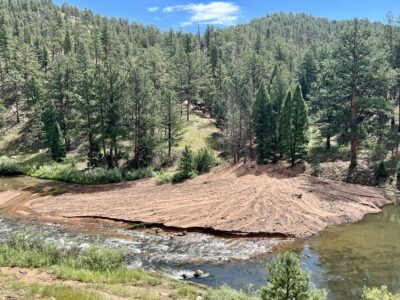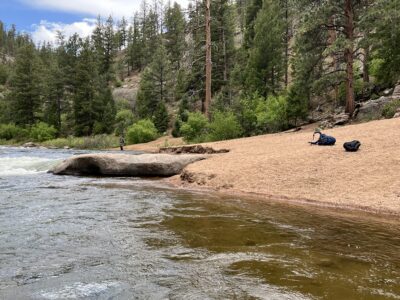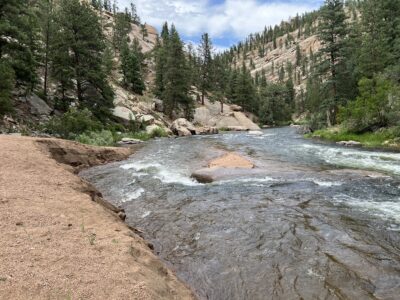Miracles Do Happen
The flash flood in Cheesman Canyon on July 31, 2023, was one of the most disappointing moments in my career. After 32 years of guiding, I’ve experienced a lot of ups and downs on my home river. This latest episode pushed me to the brink!
Here’s a recap. In the mid 1990’s, Whirling Disease hit the “canyon” and decimated rainbow populations. Then came the high-water season of 1995 when outflows below Cheesman Dam reached 3200 cfs. This event was one for the ages! 1999 was another high-water year that wreaked havoc on the fishery. In 2002, the Hayman Fire scorched 147,000 acres that had a long-lasting effect on the South Platte River and surrounding area.

The washout at the Emerald Pool was mind boggling. This alluvial fan filled in the lower canyon’s legendary holes that tailwater junkies alike have come to depend on.
Last year’s devastating act of nature was unimaginable. A massive thunderstorm set up above the Hayman Fire burn scar and absolutely pounded the area. Trust me on this….it was brutal! I was there with Meg Renton and Scott Tampa, hunkered down under a rock tunnel near the head of Cattle Crossing.
No one really knows how much rain fell that day, but Denver Water’s rain gauge up near the Cheesman Reservoir measured over three inches in an hour or so. The damage up near the reservoir was minimal in comparison to the devastation in other parts of the upper, middle, and lower canyon, not to mention the renowned Deckers area. My guess is that 4-5 inches fell that afternoon, but I have no way of telling. Renton and Tampa are my witnesses; it was intense!
Huge sediment slides (decomposed granite) that came down from the steep burned-out canyon walls produced massive alluvial fans that entered the river and immediately started moving granite and other nasty debris downstream, filling in some of the prime riffle, run, and pool tail-outs. In less than 2 days, the river was in complete shambles.
Over the winter and early spring, not much changed, as the outflows from Cheesman Dam were low as Denver Water was filling the reservoir. Denver Water could not do a “flush” last summer because it’s illegal to move water unless there is a “call for water”. Most people don’t understand the complexity of water rights and the legality of downstream demand.
This left Mother Nature in charge…and believe me, I did not have a lot of confidence that things would change in my lifetime. I caught so much flack when I shared my concern about the river last year. People were commenting “This is normal”, “Quit your whining, this kind of stuff happens all the time”, “Get over it; and move on”, “Lose one hole and you gain another one”, “We see storms like that all the time”, etc. I can assure you that the damage was not normal; it was a 1000-year flood that set up in the right place at the wrong time. It was a complete disaster!
Die-hard “canyon anglers”, especially Colorado natives like myself know what I’m talking about. They felt my pain and were sick to their stomach when they witnessed the aftermath of this flood.
Legendary holes like the Hell’s Half Acre, Rainbow Pool (pictured below), Blitz Riffle, Cattle Crossing, Emerald Pool, Meat Hole, Ice Box and the Family Hole to name only a few, were completely devastated, filled in with decomposed granite, reducing the trout’s habitat. Tuck Squier and his colleagues, the fellas that named these famous holes, must have been rolling over in their graves. I knew only time would tell the fate of this world-class fishery.
 Peanut Rock (Rainbow Pool) on May 29, 2024. Before the flash food, the river flowed where our backpacks are sitting on the sediment slide. This is one of the most famous holes in the canyon.
Peanut Rock (Rainbow Pool) on May 29, 2024. Before the flash food, the river flowed where our backpacks are sitting on the sediment slide. This is one of the most famous holes in the canyon.
Miracles do happen, but all the stars had to align. It all began with an above average snowpack in 2024, which equated to 123 percent of normal in the South Platte drainage. The last high-water year was 2014, when outflows reached 2300 cfs below Cheesman Dam. This unusually high-water year is what helped Cheesman Canyon bounce back after the Hayman Blaze in 2002.
My concern for the fishery was legitimate. In the past decade, Cheesman Reservoir did not “fill and spill” three of those years and the outflows rarely got over 400 cfs. A metropolitan area bursting at the seams is constantly using a lot of water, draining our reservoirs for day-to-day living, so it has become harder than ever to fill the reservoirs, let alone have a surplus of water flowing over the spillways. Looking at the previous decade’s data, you can see why I was less than optimistic that we would get a flush from Mother Nature.
If we did not get an above average snowpack this season, trees, bushes, grasses, weeds, and other ground foliage and plants would have taken a strong foothold in the sediment slides making it nearly impossible for the granite to move downstream. Time was of the essence…it had to happen this year if we had any chance of the “canyon” recovering.
Early this spring, things were looking good in the South Platte corridor. Spinney Reservoir was nearly full for the first time in a decade, Eleven Mile Canyon Reservoir was full, Cheesman Reservoir was at 90 percent capacity and the snowpack was looking good. The above average reservoir storage in the South Platte corridor was key. Then we got a big spring storm that put us over the top, surging our snowpack way above normal. Oddly enough, we got 4 inches of rain above the reservoir that filled the lake and run-off had not even started yet.
By the grace of God, my prayers were answered. Cheesman Reservoir began spilling on May 15, 2024. It was like the good old days when I started my career. You could bank on the reservoir spilling the first part of May. Outflows were steadily rising but we were not getting the flush we needed because it was a gradual increase in flow. It was no doubt making a difference but some of the areas where the biggest sediment slides occurred were not getting scoured out.
My colleague, John Keefover and I, routinely broke off the leading edges of some of the sediment slides (stomped on them with our wading boots) to assist in getting the granite moving downstream. We could do only so much, but we kept plugging away at it. Many of our customers assisted in the process. We greatly appreciate your help and concern to help the fishery out.

Peanut Rock, three hours after the flush. A wall of decomposed granite, 20 feet deep, and 15 feet wide was swept away, opening up the original channel, river left, looking downstream. This was truly a miracle, one that I will never forget.
This is where things get really interesting. On Wednesday, June 14, 2024, in the afternoon, I took a water temperature, and it was 62 degrees, which was very concerning to me, since I was only a couple miles down from the dam. My fear was that the lower river was going to start getting into the upper 60’s and we would start to see a fish kill. I reached out to Denver Water the following morning, via email before my guide trip, and as they normally do, they came to the rescue. That morning around 9 a.m. Nathan Elder, Raw Water Manager for Denver Water, made the decision to let 200 cfs of water off the bottom of the reservoir to cool down the water temperatures. That surge of water, 200 cfs, was a game changer! If you look at the graph it went straight up, from 675 to 875 cfs. The water rose a foot and began carving out areas like Hell’s Half Acre, Rainbow Pool, and Emerald Pool, three of the biggest sediment slides in the canyon.
Talk about the stars aligning…several feet of the granite slides were literally swept away in three hours. Trees were floating down the river, big logs, and so much debris was getting cleaned out. The river below Peanut Rock was muddy for miles, but it was exactly what the river needed.
When I got home that evening, I emailed Nathan Elder and thanked him from the bottom of my heart. He replied, “Thanks for the kind words, but I was just doing my job.” That’s Nathan…he always has my back. Nathan, you are a class act my friend. Denver Water has been a huge friend to our finned friends, they always listen to my input and do what they can to help the resource. I am forever grateful for a phenomenal relationship that I have with Denver Water.
Against all odds, the recovery process has begun in Cheesman Canyon, and no one could be happier than myself. Several key factors set the stage for this to happen. The releases below Antero Reservoir peaked at nearly 200 cfs this year, which is double its normal outflow. Elevenmile Reservoir’s outflows peaked at 625 cfs, which is 400 cfs over its historic levels, and the outflows below Cheesman Reservoir were 2.5 times higher than normal this year. Tarryall Creek was a huge contributor to the inflows above Cheesman Reservoir (it peaked at 375 cfs) helping outflows below Cheesman Dam reach nearly 1000 cfs.
We’re not out of the woods yet, because there is so much sediment that has to move down the canyon. The aquatic life has taken a huge hit and the rainbow recruitment this year will be minimal. The rainbows tried to spawn, but their redds got buried by decomposed granite despite their amazing efforts. The challenge is that we will lose a year class to attrition, and we’ll lose most of this year’s young of the year.
In my humble opinion, that’s a small price to pay for what has happened in the past 10 days. I never imagined a flush of this type would happen in my lifetime, but everything fell into place, despite the odds. I will keep you updated as things change. Thanks for your support and understanding through this most difficult and challenging time. The “canyon” regulars felt my pain from day one, they supported me, encouraged me, didn’t fish the canyon when the fish were stressed from all this turmoil. To all of you; I thank you!

Thanks for the detailed explanation!
Thanks for reading the blog. I greatly appreciate your support.
Pat,
Thanks for your update. The Canyon is a very special place and it needs people like yourself who are passionate about trying to keep it that way.
Thank you Pat, Yes they do… Miracles.
Your South Platte presentation at the Fly Fishing Show in Denver was alarming.
You spoke about the disaster and the decomposed Granite covering Cheeseman.
What a turn of events. 200CFS, Thank you Nathan Elder job well done. 😉
Stars align and Mother nature smiles every now and again upon cooperating anglers.
Tight Lines